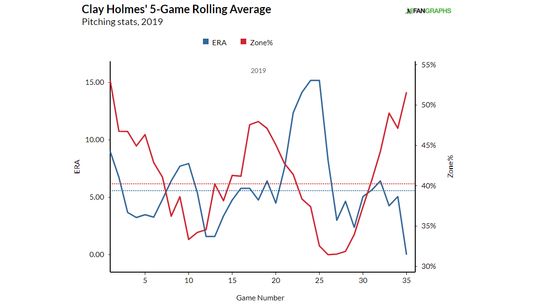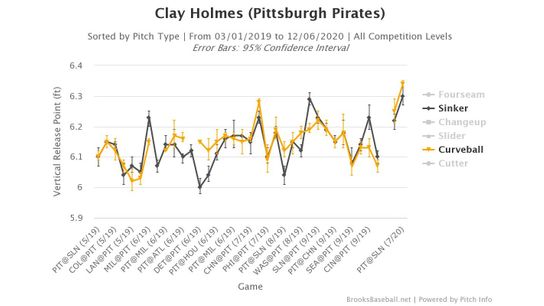On Wednesday, the Pirates opted to non-tender just one player, right-hander Clay Holmes, in order to clear a spot on the 40-man roster ahead of the Winter Meetings. He wasn’t gone for long, signing a minor-league deal with the only club he’s ever been with two days later which included an invitation to spring training.
In the grand scheme of things, his situation barely changed. He is out of minor-league options, so he would need to earn a roster spot out of spring training or be let go anyway.
He was in the same boat last year, but barely had a chance to actually prove he was a major league pitcher. He was drilled by a comebacker on Feb. 29, causing a fracture in his right foot. It put him in a boot, but in an odd way, the injury could have helped his odds of making the team. Instead of being in a competition for a spot, he would start the season on the injured list. Then he would get a long rehab assignment, and if there’s a spot available, he would slide into the bullpen. Not a bad pathway to the majors.
But there was, you know, a pandemic, so throw that idea out the window.
As a positive, when baseball did resume, rosters were expanded to accommodate the shorter ramp up time before the season started, essentially guaranteeing a spot in the majors again.
His season lasted just one game, quickly suffering a right forearm strain and spending almost the entire campaign on the injured list. He was able to avoid a second Tommy John surgery, but he wasn’t going to be able to pitch in a crucial year of his career. That, paired with his poor results in the majors thus far, is why the Pirates opted not to keep him on the roster.
Despite that, there is still some promise, which is why the Pirates didn’t want to cut ties with him.
Let’s take a look back to Holmes’ 2019 season. He bounced between the majors and minors and finished with a 5.58 ERA and 1.62 WHIP over 50 innings pitched. He wasn’t exactly hit hard, though. His average exit velocity allowed was league average, which was fine considering he had a ground ball rate just north of 60%. Giving up hard-hit ground balls won't kill you.
Per Baseball Savant data, he finished in the 84th-percentile in the rate he allowed barrels. That’s good! He also finished in the 68th percentile in expected batting average, 74th in expected slugging percentage and 64th in whiff rate. Good, good and good! It seemed like the foundation for a solid season.
And it would have been, if he could have found the strike zone. Holmes walked 36, or 15% of his batters faced, and hit nine more. He allowed 45 hits and put 45 batters on base for free. Batters didn’t beat him, he beat himself.
Which is why when you look at that year, it’s no coincidence that when he was actually throwing it in the zone, he did quite well. When he was wild, the ERA skyrocketed:

FanGraphs
Holmes’ stuff gets an absurd amount of movement. In 2019, his sinker ranked third in vertical drop and his curveball averaged nearly 2,700 RPM of spin. Batters couldn’t square it up, but they didn’t need to.
It was a very similar season to another sinker baller on the staff, Geoff Hartlieb. In 2019, his sinker actually ranked fourth in vertical drop, barely behind Holmes, and he too had a high spin breaking pitch. People didn’t pay attention to that though because he got lit up for an ERA of 9.00 and was wild.
But his 2020 season was different, thanks in large part to Oscar Marin’s coaching. He cleaned up some arm action, strictly became a sinker-slider pitcher and changed his arm slot for a higher release point. It worked, and even with a late season stumble, he finished with a 3.63 ERA and a 0.76 WPA. He became the bullpen’s fireman, stranding inherited runners in pivotal moments.
We might have seen Holmes making the same changes Hartlieb did in his brief appearance last year. Mechanically, he did simplify his delivery, eliminating the glove motion during his windup and instead just going straight back. The top video is from 2019, the bottom from 2020:
And the release point was higher, suggesting he might have tweaked his arm slot. His two primary pitches, the curve and sinker, left the hand at a higher point than any game he had in 2019:

Brooks Data Baseball
It was only one outing, so don’t put too much stock into any actual results from that day, though it was quite good. The takeaway is we saw some tweaks that have Marin’s fingerprints all over. That doesn’t guarantee success, but it worked for Hartlieb, who is a very similar pitcher.
Holmes and Hartlieb both have good stuff and don’t give up a lot of fly balls. When there’s that much vertical movement, pitchers can get away with hanging a couple because it’ll very likely just get beaten into the ground. It just needs to get in the strike zone.
Holmes will be 28 by the time the 2021 season gets underway. It is a make-or-break year for him. There will be jobs in the Pirates’ bullpen up for grabs. If he can get out of his own way, he could get one.
